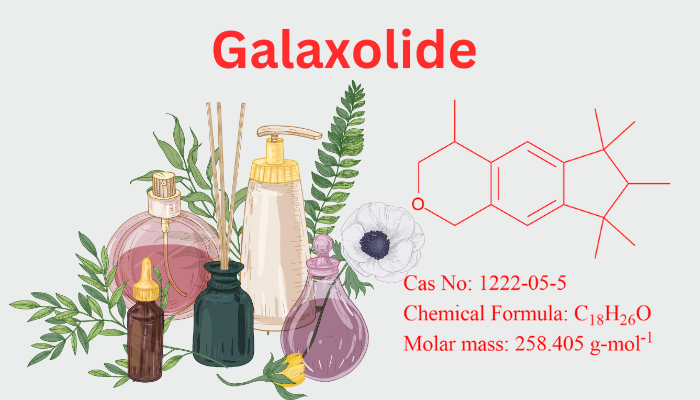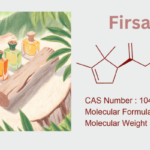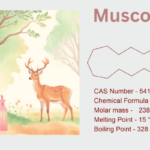Few compounds have attained the legendary status of Galaxolide in the alchemical realm of scent. Galaxolide, a synthetic musk with a fresh, velvety scent, has emerged as a key component of contemporary fragrances, serving as a foundation for anything from body lotions to high-end designer scents. Beyond its aromatic appeal, however, is a tale of chemical ingenuity—a story of how organic synthesis turned a lab product into a vital perfumer’s tool. This article explains why Galaxolide is the most popular molecule in the $50 billion fragrance market by examining its molecular makeup, industrial manufacture, and long-lasting attraction.
1. The Molecular Identity: Decoding Galaxolide’s Structure
Galaxolide (C₁₈H₂₆O) is a member of the polycyclic musk family and is distinguished by its complex carbon ring configuration. Its complexity is hinted at by its IUPAC nomenclature, 1,3,4,6,7,8-hexahydro-4,6,6,7,8,8-hexamethylcyclopenta[γ]-2-benzopyran:
- A tetralin core, which is a benzene and cyclohexane bicyclic system fused together.
- Its stability and fragrance are influenced by two methyl groups and a lactone ring that contains oxygen.
In contrast to natural musks made from animal glands (such as musk deer), Galaxolide’s synthetic composition offers better consistency and longevity without raising ethical questions. Its chemical structure enables it to gradually attach to olfactory receptors, delivering its distinctive “clean musk” scent over several hours.
2. Synthesis of Galaxolide: Crafting Complexity in the Lab
The polycyclic framework of galaxide is constructed by Friedel-Crafts alkylation and cyclization, making its synthesis a marvel of organic chemistry. Here is a detailed explanation:
Step 1: Formation of the Tetralin Core
Derivatives of isobutylene and benzene are used to start the reaction. By alkylating benzene with a Lewis acid catalyst (such as aluminum chloride), a Friedel-Crafts reaction produces an intermediate tetralin.
Step 2: Introduction of Methyl Groups
Methyl chloride or dimethyl sulfate are used to methylate the tetralin molecule. The distinctive methyl groups that improve Galaxolide’s volatility and diffusion are added in this stage.
Step 3: Lactone Ring Formation
The lactone ring that contains oxygen is closed by a cycloetherification process. This process, which is frequently triggered by enzymatic or acidic environments, is essential for stabilizing the molecule and adjusting its muskiness.
Step 4: Purification
Vacuum distillation and crystallization are used to purify the crude product, eliminating leftover catalysts and byproducts such as unreacted tetralin. The finished product satisfies International Fragrance Association (IFRA) criteria with a purity of >98%.
3. Sources of Galaxolide: From Lab Bench to Global Markets
A small number of chemical giants dominate the manufacturing of galaxide, which is entirely synthetic:
- Firmenich (Switzerland): a leader in the production of musk, accounting for over 40% of the world market.
- International Flavors & Fragrances (IFF) (USA): renowned for using premium perfumes that contain high-purity galaxide.
- Symrise (Germany): Emphasizes solvent recycling and other sustainable industrial techniques.
3.1. Raw Materials:
Although some producers are looking into bio-based substitutes (such as terpenes from citrus waste), essential precursors like benzene and isobutylene are obtained from petroleum refining.
4. The Fragrance Profile: Why Galaxolide Dominates Perfumery
4.1. Galaxolide’s scent is often described as:
- Musky: An undertone of warmth and animalism that is reminiscent of vintage musks.
- Clean: Evokes freshly laundered linen or mountain air.
- Lingering: serves as a fixative, delaying the evaporation of a perfume blend’s top notes, such as citrus.
4.2. Applications in Perfumery:
- Fine Fragrances: found in well-known fragrances such as Calvin Klein’s Eternity and Dior’s Miss Dior.
- Cosmetics: Adds depth to shampoos, deodorants, and candles.
- Functional Products: covers up the smells of fabric softeners and detergents.
5. Challenges and Innovations: Balancing Demand and Sustainability
5.1. Despite its ubiquity, Galaxolide faces scrutiny:
- Environmental Persistence: It builds up in waterways because it is a polycyclic musk that is resistant to biodegradation. Strict monitoring of its environmental impact is required by the EU’s REACH law.
- Regulatory Hurdles: Because of sensitization concerns, IFRA limits its concentration in leave-on goods (such perfumes) to 1.4%.
5.2. Green Chemistry Advances:
- Enzymatic Catalysis: minimizing energy use by streamlining lactone production with lipases.
- Bio-Based Feedstocks: Experimental methods for producing tetralin precursors utilizing limonene (found in orange peels).
6. The Future of Galaxolide: Beyond the Musk
The molecule’s legacy is evolving:
- Microencapsulation: Galaxolide is embedded in silica nanoparticles for smart fabric controlled release.
- Synergy with AI: New Galaxolide compounds with improved biodegradability are predicted using machine learning techniques.
7. Conclusion: The Molecule That Redefined Modern Scent
The development of galaxide from a laboratory discovery in the 1960s to a mainstay in perfume illustrates the potential of synthetic chemistry. It gave perfumers an unmatched creative tool while resolving the supply and ethical issues around natural musks. Galaxolide’s tale is far from ended as the industry shifts toward sustainability; it serves as a model for innovation and demonstrates that molecules may be both revolutionary and functional.
A wonderful fragrance, in the words of perfumer Christophe Laudamiel, is a harmonious blend of art and science. Galaxolide exemplifies this balance with its flawless synthesis and classic charm.










